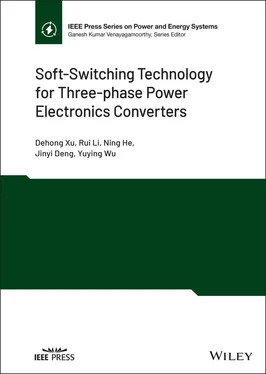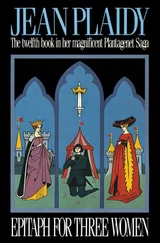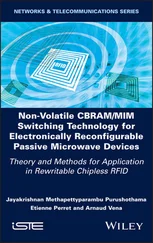1 Cover
2 Series Page IEEE Press 445 Hoes Lane Piscataway, NJ 08854 IEEE Press Editorial Board Ekram Hossain, Editor in Chief Jón Atli Benediktsson Xiaoou Li Jeffrey Reed Anjan Bose Lian Yong Diomidis Spinellis David Alan Grier Andreas Molisch Sarah Spurgeon Elya B. Joffe Saeid Nahavandi Ahmet Murat Tekalp
3 Title Page
4 Copyright Page
5 Preface
6 Nomenclature
7 Part 1: Fundamental of Soft‐switching 1 Introduction 1.1 Requirement of Three‐phase Power Conversions 1.2 Concept of Soft‐switching Technique 1.3 Applications of Soft‐switching to Three‐phase Converters 1.4 The Topics of This Book References 2 Basics of Soft‐switching Three‐phase Converters 2.1 Introduction 2.2 Switching Characteristics of Three‐phase Converters 2.3 Classification of Soft‐switching Three‐phase Converters 2.4 DC‐side Resonance Converters 2.5 AC‐side Resonance Converters 2.6 Soft‐switching Inverter with TCM Control 2.7 Summary References 3 Soft‐switching PWM Control for Active Clamped Three‐phase Converters 3.1 Introduction 3.2 PWM of Three‐phase Converters 3.3 Edge‐aligned PWM 3.4 ZVS Active‐clamping Converter with Edge‐aligned PWM 3.5 Control Diagram of the Converter with EA‐PWM 3.6 ZVS‐SVM 3.7 Summary References
8 Part 2: ZVS‐SVM Applied to Three‐phase Rectifiers 4 Three‐phase Rectifier with Compound Active‐clamping Circuit 4.1 Introduction 4.2 Operation Principle of CAC Rectifier 4.3 Circuit Analysis 4.4 Prototype Design 4.5 Summary References 5 Three‐phase Rectifier with Minimum Voltage Active‐clamping Circuit 5.1 Introduction 5.2 Operation Principle of MVAC Rectifier 5.3 Circuit Analysis of MVAC Rectifier 5.4 Prototype Design 5.5 Summary References
9 Part 3: ZVS‐SVM Applied to Three‐phase Grid Inverters 6 Three‐phase Grid Inverter with Minimum Voltage Active‐clamping Circuit 6.1 Introduction 6.2 Operation Principle of MVAC Inverter 6.3 Circuit Analysis 6.4 Design Prototype 6.5 Summary References 7 Three‐phase Inverter with Compound Active‐clamping Circuit 7.1 Introduction 7.2 Scheme of ZVS‐SVM 7.3 Circuit Analysis 7.4 Implementation of ZVS‐SVM 7.5 Prototype Design 7.6 Summary References 8 Loss Analysis and Optimization of a Zero‐voltage‐switching Inverter 8.1 Introduction 8.2 Basic Operation Principle of the CAC ZVS Inverter 8.3 Loss and Dimension Models 8.4 Parameters Optimization and Design Methodology 8.5 Prototype and Experimental Results 8.6 Summary References 9 Design of the Resonant Inductor 9.1 Introduction 9.2 Fundamental of Inductor 9.3 Design Methodology 9.4 Design Example 9.5 Design Verification 9.6 Summary References
10 Part 4: Impact of SiC Device on Soft‐switching Grid Inverter 10 Soft‐switching SiC Three‐phase Grid Inverter 10.1 Introduction 10.2 Soft‐switching Three‐phase Inverter 10.3 Efficiency Comparison of Hard‐switching SiC Inverter and Soft‐switching SiC Inverter 10.4 Design of Low Stray Inductance Layout in Soft‐switching SiC Inverter 10.5 Design of Low Loss Resonant Inductor in Soft‐switching SiC Inverter 10.6 Summary References 11 Soft‐switching SiC Single‐phase Grid Inverter with Active Power Decoupling 11.1 Introduction 11.2 Operation Principle 11.3 Circuit Analysis 11.4 Design Prototype 11.5 Summary References 12 Soft‐switching SiC Three‐phase Four‐wire Back‐to‐back Converter 12.1 Introduction 12.2 Operation Principle 12.3 Circuit Analysis 12.4 Design Prototype 12.5 Summary References
11 Appendix A.1 Basic of SVM A.2 Switching Patterns of SVM 12 A.3 Switching Patterns of ZVS‐SVM A.4 Inverter Loss Models A.5 AC Filter Inductance Calculation A.6 DC Filter Capacitance Calculation
12 Index
13 Books in the IEEE Press Series on Power and Energy Systems
14 End User License Agreement
1 Chapter 3Table 3.1 Vector sequences in each sector.Table 3.2 Characteristics of the converters vs. auxiliary circuit and operat...
2 Chapter 4Table 4.1 Eight switch states.Table 4.2 Switching sequence in each sector.Table 4.3 Specifications of the ZVS rectifier.Table 4.4 Resonant parameters selected.
3 Chapter 5Table 5.1 Eight switch states.Table 5.2 Modulation sequences and current commutation type.Table 5.3 Switching sequence in each sector.Table 5.3 Specifications of the ZVS rectifier.Table 5.4 Resonant parameters selected.
4 Chapter 6Table 6.1 Eight switch states.Table 6.2 Modulation sequences and current commutation type.Table 6.3 Switching sequence in each sector.Table 6.4 Switching sequence in each sector.Table 6.5 Specifications of the ZVS inverter.Table 6.6 Resonant parameters selected.
5 Chapter 7Table 7.1 Vector sequences of the ZVS‐SVM in entire 12 sectors.Table 7.2 Counter‐compare values for three‐phase bridges.Table 7.3 Specifications of the ZVS inverter.
6 Chapter 8Table 8.1 Fitting coefficients for conduction voltage of IGBT device and fo...Table 8.2 Fitting coefficients for turn‐off energy.Table 8.3 Constrained conditions.Table 8.4 Optimization design results.Table 8.5 Parameters of the inverter prototype.Table 8.6 Experiment parameters.
7 Chapter 10Table 10.1 Input and output parameters of designed soft‐switching SiC inver...Table 10.2 Parameters under different switching frequency.Table 10.3 Cores selection and volume evaluation of AC filter inductors and...
8 Chapter 11Table 11.1 Rated parameters of the prototype.Table 11.2 Specifications of the prototype.
9 Chapter 12Table 12.1 Resonant parameter and filter inductance at different switching ...Table 12.2 Circuit parameters for the ZVS BTB prototype.
1 Chapter 1 Figure 1.1 Three‐phase converters: (a) grid converters; (b) inverter. Figure 1.2 Circuit diagram of UPS. Figure 1.3 Filter inductance, weight and loss vs. switching frequency. (a) F... Figure 1.4 Power trains of electric vehicles: (a) circuit of power trains; (... Figure 1.5 DC side capacitance vs. switching frequency. Figure 1.6 Power semiconductor loss of the inverter vs. switching frequency.... Figure 1.7 Total SiC MOSFET loss of the inverter vs. switching frequency. Figure 1.8 Typical switching waveforms of a power device. Figure 1.9 Zero‐voltage‐switching turn‐on. Figure 1.10 Zero‐current‐switching turn‐on. Figure 1.11 Zero‐voltage‐switching turn‐off. Figure 1.12 Zero‐current‐switching turn‐off. Figure 1.13 Active clamping converters: (a) circuit; (b) auxiliary switch st... Figure 1.14 Single‐phase PV inverter for residential applications. Figure 1.15 Three‐phase ZVS PV inverter. Figure 1.16 Two‐stage three‐phase ZVS inverter for PV system. Figure 1.17 ZVS back‐to‐back converter for PMSG system. Figure 1.18 Paralleled three‐phase ZVS inverter for BESS. Figure 1.19 ZVS inverter with front boost stage for BESS. Figure 1.20 ZVS inverter with paralleled DC/DC converters for BESS. Figure 1.21 Multiple energy storage system with ZVS converters. Figure 1.22 ZVS inverter for APF/STATCOM. Figure 1.23 ZVS converter for DVR. Figure 1.24 ZVS converter for UPQC. Figure 1.25 UPS with the auxiliary resonance circuit for soft‐switching. Figure 1.26 High speed drives with auxiliary resonance circuit. Figure 1.27 Soft‐switching EV charger. Figure 1.28 ZVS totem power‐factor‐correction circuit.
2 Chapter 2 Figure 2.1 Three‐phase converters: (a) grid converters; (b) inverters to sup... Figure 2.2 Control of three‐phase converter. Figure 2.3 PWM signal generation. Figure 2.4 Switch leg of phase‐a. Figure 2.5 Key waveforms of phase‐a switch leg in a switching cycle. Figure 2.6 Commutation from upper switch S 1to the antiparallel diode D 4of ... Figure 2.7 Turn‐off transient waveforms of an IGBT device (1.7 kV/400 A modu... Figure 2.8 Commutation from lower diode
Читать дальше











